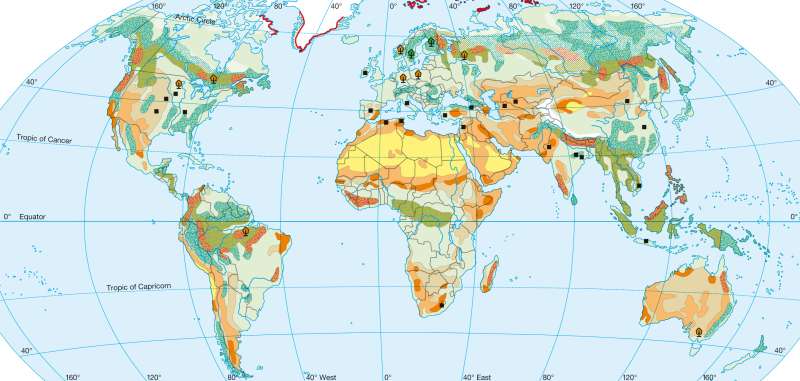Landscape change
The world - Environment
978-3-14-100790-9 | Page 198 | Ill. 1

Information
The map highlights two phenomena that are both an ecological and economic threat: forest decline and desert expansion. These two phenomena often occur side by side in the arid regions of the world.Particularly affected by forest decline are regions of the boreal coniferous forests (especially in Russia), the Himalayan mountain forests and the tropical forests (Amazonian lowlands, West Africa, Madagascar, India, Southeast Asia). It is clearly evident that forests, in particular in regions with a low economic status and a high rate of population growth i.e. in the developing countries, are placed under great pressure. In contrast North America and most states of Western or, more precisely, Northern Europe (apart from a few exceptions) have developed a form of sustainable forestry, which guarantees that forests are protected and cared for according to the principles of sustainability.
The spread of deserts mostly takes place at the edge of the large deserts (Atacama, Sahara, Great Arabian Desert, Taklamakan, Gobi), but also in other arid regions. The human-induced transformation of the landscape in arid regions is of particular significance as this results in the ongoing process of degradation (desertification). Desertification leads to the destruction of vegetation and decreased soil productivity, ultimately resulting in man-made deserts and therefore having a negative impact on food sources. The causes that trigger or, as the case may be, increase and control this process can vary greatly depending on the region; the resulting ecological damage can also prove to be very different. Significant factors are the overgrazing of grasslands, the implementation of unsuitable agricultural methods (e.g. converting grasslands to cropland) and deforestation (e.g. due to high demands for firewood). All of these factors are related to the growing population in affected regions.
On a global scale forested areas have been declining for a long time, although regional distinctions must be made. For example in North America and large parts of Europe, in particular Western Europe, forest areas have increased in size in recent years, whereas in other parts of the world, almost without exception, forests have declined. Worst affected are the tropical regions. These losses however haven't developed in all regions to the extent that was feared several years ago.
The problem of desert expansion has been cause for concern for many years now. Numerous measures are being implemented to protect the livelihoods of the population in affected regions. The United Nations Convention to Combat Desertification (UNCCD) has been in operation since December 1996 — it is administered by the UNCCD Secretariat based in Bonn, Germany. The Convention initiates and coordinates numerous programmes and measures in order to combat desertification.
M. Felsch, K. Lückemeier, V. Hochschild; Ü: J. Moar, M. Dahl




